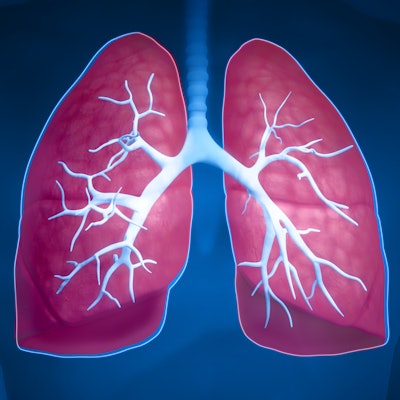
Incidental lung nodules on routine CT may develop into cancer. But they can be effectively tracked with a well-designed follow-up program based on artificial intelligence (AI), according to a May 25 talk at the virtual Society for Imaging Informatics in Medicine (SIIM) meeting.
A team from St. Joseph Mercy Health System in Detroit described how their radiology department developed an AI-based early intervention program for patients with incidental lung nodule findings on CT that has improved outcomes and timeliness of care -- and it also offers physicians protection from liability.
"An integrated care model with a seamless combination of nurse navigation and optimal use of health information technology improves care and outcomes for patients with incidental pulmonary nodules, while simultaneously mitigating liability for physicians and healthcare institutions," said presenter and clinical quality project specialist Ruth Raleigh.
In 2012, St. Joseph's performed a risk root cause analysis in response to a case of a patient who had undergone chest CT in the emergency department. Although the radiology report noted that there was an incidental lung nodule on the exam and follow-up should be conducted, this recommendation was not shared with the patient and did not occur, Raleigh said.
The patient returned to the healthcare system with advanced lung cancer -- one of seven patients to do so, Raleigh said. In fact, the analysis showed that only 36% of incidental lung nodules found on CT were being tracked.
The outcome of the root cause analysis was the launch of a safety-net initiative called the Incidental Lung Nodule program, launched in 2014. The program has had dramatic results: In early days, it identified 500 patients per month for lung nodule follow-up, according to Raleigh.
The program incorporates AI and includes the following features, said St. Joseph Mercy Health Systems RIS coordinator Rachel Bush:
- When an incidental lung nodule is identified, the radiologist recommends follow-up based on American College of Radiology (ACR) guidelines and their own expertise.
- Lung nodule identification is standardized: Those nodules that require notification to the ordering physician as well as tracking by nurse navigators get flagged by the radiology as a "communication required" message; those that require tracking only by nurse navigators are marked as a "log-only" message.
- Nurse navigators follow up with both the ordering provider and the patient.
- After follow-up has occurred, the need for further tracking is noted or, if tracking is complete, that is noted as well.
The AI software includes workflow features like patient exam alerts, automated task lists to track those exams, and integrated tools for communicating between navigators, providers, and patients, Bush said.
"[We found that] engaging physician leadership helped us implement the program," she said. "We developed a database [to track] patients and exams, coordinated communication with primary care providers, and established a lung nodule clinic."
The program has dramatically improved St. Joseph's follow-up "closure rate," and gives a clear picture of the reasons follow-up has been resolved, Bush said.
"We set the program with a follow-up closure rate of 75%, but as a result of [using the AI software] our rate has been closer to 99%," she said.
Finally, the team has seen an increase in CT volume since the program was implemented, Raleigh noted.
"From our data [February 2020 to the present], we saw a measured increase in CT volume ... of 22%, most of which is attributed to appropriate lung cancer follow-up," she said.
Going forward, St. Joseph is expanding the lung nodule program to include all incidental findings, including thyroid and gastrointestinal studies, according to Raleigh.
"We're developing a process for connecting patients with likely cancers to oncology nurse navigators earlier," she said. "Our goal is to decrease patient anxiety, reduce inpatient admissions for cancer workups, and retain patients in the healthcare system."



















